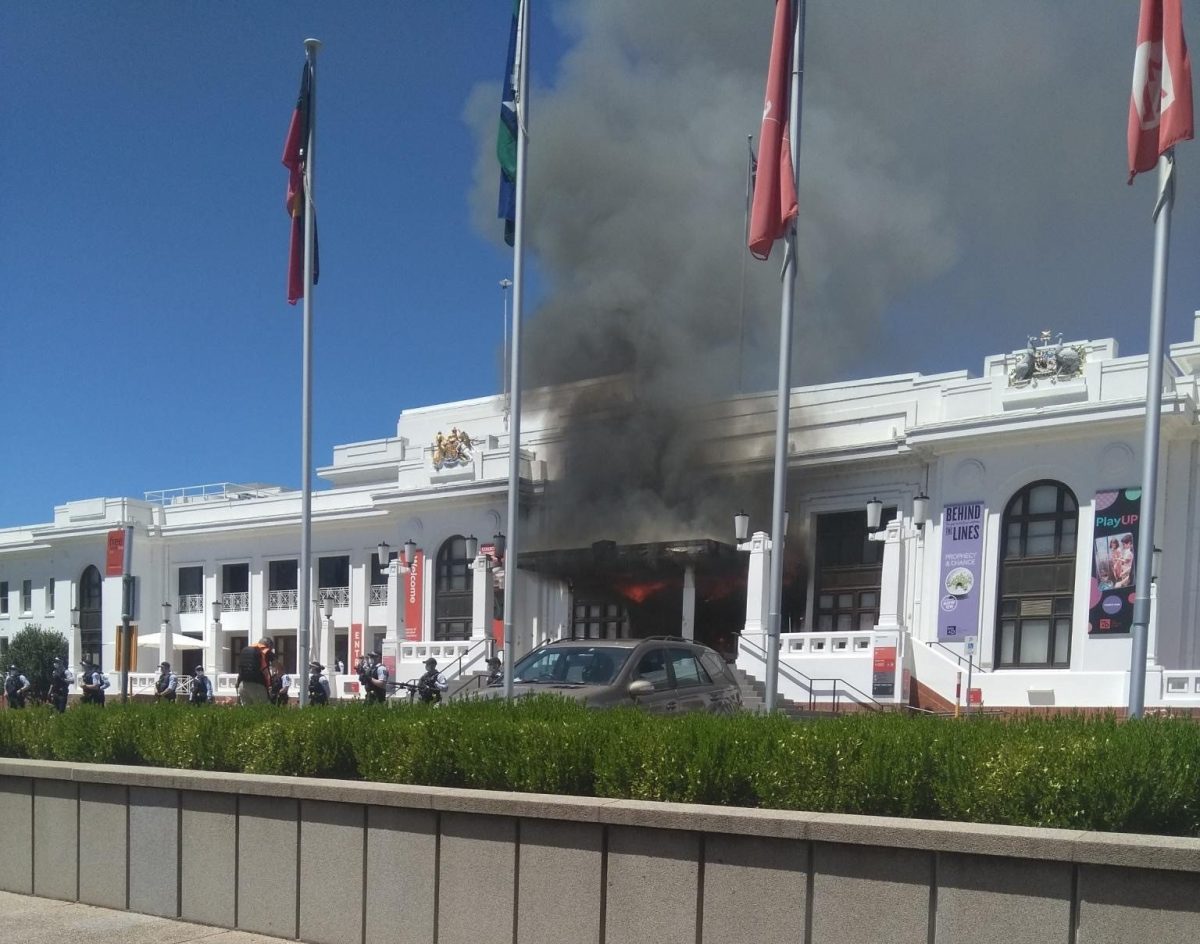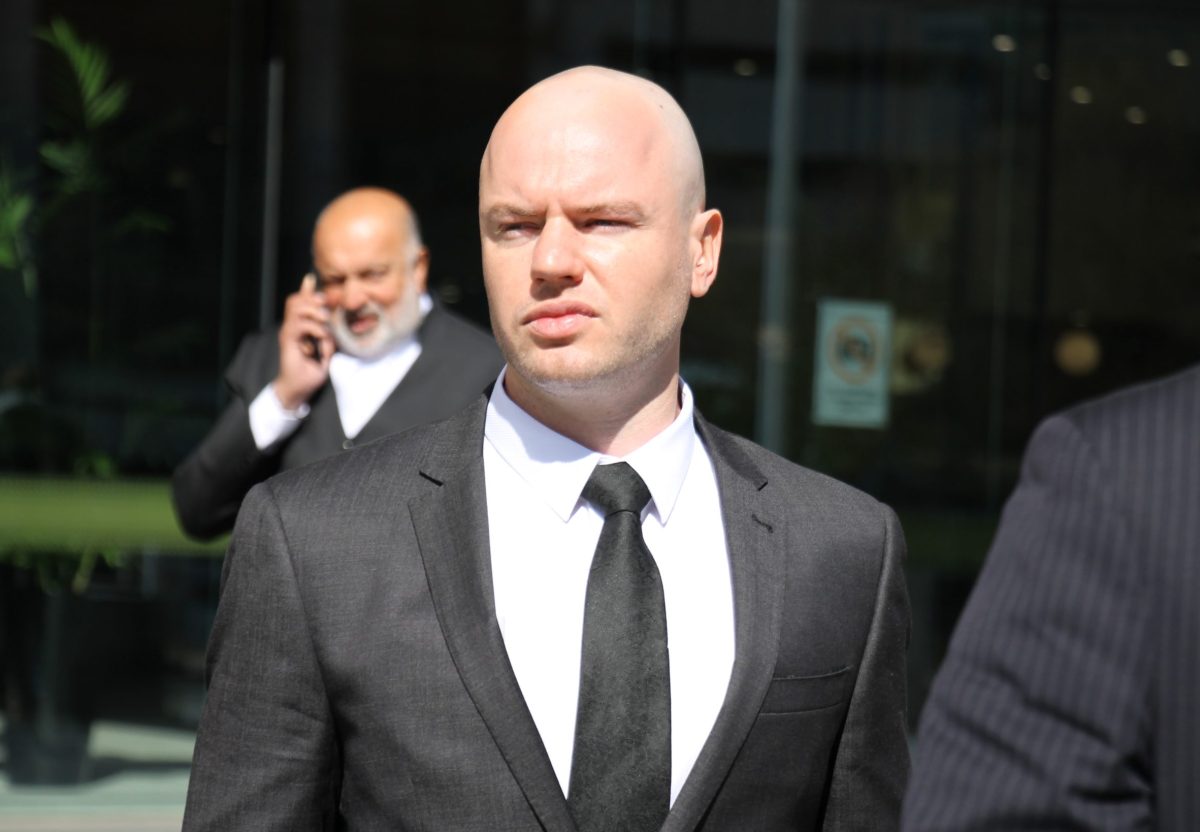
Bruce Shillingsworth Jr, 32, had been found guilty of aiding and abetting arson. Photo: Albert McKnight.
The protest leader who helped an arsonist start the damaging fire at Old Parliament House was spared being sent to jail when he was sentenced after telling a court it wasn’t his intention to come to Canberra and “burn down the doors”.
Nicholas Malcolm Reed was found guilty of starting the 30 December 2021 fire, which caused $5 million worth of damage to the heritage building, while jurors also found that Bruce Shillingsworth Jr had helped him commit the crime.
Late last year, Reed was handed one year and 11 months in jail, suspended after he spent eight months behind bars; then, on Thursday (23 February), Shillingsworth was sentenced to one-and-a-half years’ jail, fully suspended.
Justice David Mossop said for a number of days there had been peaceful protests outside the building, of which Shillingsworth had been a leader, where he made speeches on themes like sovereignty and the need for justice.
On 30 December, Reed parked a car near the building, pulled a wooden shield out of it, lit a fire near the steps and used the shield to carry hot coals to the portico. He also collected bundles of sticks and took them to the portico, adding them to the fire at the doors.
Meanwhile, Shillingsworth encouraged another protester to paint over a security camera at the portico while he painted glass panels near the doors.
He then gestured at the other protesters to join him, and they prevented access to the area where the fire was growing at the doors by linking arms and forming a ring around the portico.
When police officers arrived to try to reach the fire, the protesters, including Shillingsworth, resisted their attempts to break through their lines. He was seen on body-worn camera footage yelling at the others, “Hold”.
In order to avoid a more violent confrontation, the officers were told to stop trying to break through the line and retreat into the building. The fire grew, engulfed the portico and caused significant damage, including to furniture and artwork inside.

A fire started at the Old Parliament House on 30 December 2021 during protests at the building. Photo: Supplied.
Justice Mossop said the protests were related to the past and present treatment of First Nations people and that to the protesters, Old Parliament House was symbolic of Australian Government institutions.
He described Shillingsworth as a “forceful and charismatic leader” of the protesters who was influential when it came to the conduct of others. He’d also demonstrated limited remorse for his conduct.
Jurors in the ACT Supreme Court trial had found Reed guilty of arson, while Shillingsworth was found guilty of aiding and abetting arson.
Shillingsworth also pleaded guilty to a charge of defacing public property, while Justice Mossop found him guilty of assaulting a frontline community service provider and obstructing a territory public official.
Earlier on Thursday, the court heard Shillingsworth did have some empathy for the frontline workers responding to the fire. He was asked if that included the damage caused to the building.
“Property is different to people. We had no intention to causing harm to any individual,” the 32-year-old said.
“It wasn’t the intent to come to Canberra, the ACT, and burn down the doors.”
He said he and the other protesters had been at the location for months and were speaking to police but claimed the museum’s board had declined to meet with them multiple times for a conversation.

Nicholas Malcolm Reed was aged 32 when he was sent to jail last year. Photo: Albert McKnight.
His barrister, James Sabharwal, said his client, who lives in Sydney, was not as culpable for the crime as much as Reed had been, as he hadn’t touched or lit the blaze.
He raised the hardship that Shillingsworth’s four children would face if he was remanded in custody and said Justice Mossop could impose a suspended sentence. Prosecutor Beth Morrisroe said she wouldn’t oppose such a sentence.
Justice Mossop told Shillingsworth that when deciding on sentencing, he had been significantly influenced by the prosecutor’s stance. However, he said such a sentence would only be appropriate if it came with a lengthy good behaviour order and fine.
In addition to his suspended sentence, Shillingsworth was handed a three-and-a-half-year good behaviour order and fined $8300.



 , make a mistake and then be the hero that fixes it. Level the whole…
, make a mistake and then be the hero that fixes it. Level the whole… 














